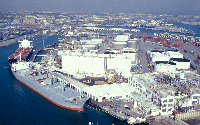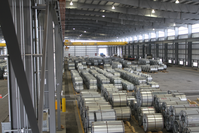Shipping and Logistics

Ports Expecting Continued High Levels of Steel Imports
Written by Sandy Williams
April 2, 2015
Steel import levels continue to increase at ports around the U.S. SMU spoke with several ports and all but one expects imports to grow, not decrease, in the coming months.
Out on the West Coast, the Port of Los Angeles is still working through congestion brought about by the recent labor dispute and chassis issues. According to Philip Sanfield, Director of Media Relations at the Port of Los Angeles, congestion is improving with fewer ships at anchor and less dwelling time at the docks. In-and-out time for vessels has shortened. Improvements have been made in the process of distribution of chassis for unloading cargo. The Port of Los Angeles handles 95 percent container cargo and Sanfield surmised that steel imports and other break bulk cargo have been less impacted by the port congestion.
 The ILWU/PMA labor issue is moving along and union leaders are in the Bay area discussing whether to put the tentative agreement to vote by the general membership. The Port is “cautiously optimistic” that the vote will take place and a successful resolution will be achieved by mid-May.
The ILWU/PMA labor issue is moving along and union leaders are in the Bay area discussing whether to put the tentative agreement to vote by the general membership. The Port is “cautiously optimistic” that the vote will take place and a successful resolution will be achieved by mid-May.
The Gulf ports are seeing burgeoning levels of steel imports. At the Port of Houston in February 2015 641,091 short tons of steel were imported and 55,001 tons were exported. The totals do not cover the significant amounts handled by private terminals at the Port of Houston. Year to date, Port of Houston steel totals are 38 percent higher than the same period in 2014.
Bill Hensel, Corporate Communications Manager for the Port of Houston expects import tonnage volume to slow in the coming months.
Georgia Ports Authority, Global Accounts Executive, Mark Troughton believes that “the import of steel into the U.S. for the automotive sector will continue to increase because of the strong dollar versus the Euro and due to strong U.S. auto sales in North America.”
“Many of the auto manufacturers are building plants or expanding plants in the Southeast region,” said Troughton in an email. “I think we may see some slight increases in construction related materials as the U.S. economy improves. We don’t handle oil well products in our area, but the U.S. Gulf could show declines because of the lower oil prices. Many of the wells are being capped until oil prices improve.”
Congestion at the Port of Savannah is not an issue according to Curtis Foltz, Executive Director, Georgia Ports Authority.
“On the East Coast, other gateways are dealing with volume of service challenges,” said Foltz. “However, as a result of our forward-thinking investments, the Port of Savannah has not suffered from the same congestion woes. Our status as the largest single-operator terminal in the country — at 1,200 acres with 22 ship-to-shore cranes — means we have the space and equipment to accommodate influxes of cargo. Also, with 116 rubber-tired gantry cranes, Garden City Terminal is handling 10,000 gate moves per day, which includes our containerized steel imports. Both Garden City Terminal and our dedicated breakbulk facility at Ocean Terminal feature on-terminal rail with service from Norfolk Southern and CSX. Our location west of the city center and only 6 miles from Interstates 16 and 95, means cargo can move out by truck or rail without traffic delays.”
The Port of New Orleans reports steel volumes in 2014 rose 101.6 percent to 3.54 million tons due to large increases in coils and slabs. Matt Gresham, Director of External Affairs, reports no congestion issues at New Orleans. “Also, the Port did add an additional breakbulk liner service recently – Saga Welco – monthly liner service for Asian and South American markets,” said Gresham.
 The Alabama State Port Authority reports steel imports are up, mostly sheet pipe and discrete plate. “We anticipate imports could creep upwards due to the value of the dollar, but we do not expect declines,” said Judith Adams, Vice President Marketing. “As for congestion – none at the Port of Mobile. Our facilities have capacity; in fact we just dedicated a $36M steel coil handling facility yesterday.”
The Alabama State Port Authority reports steel imports are up, mostly sheet pipe and discrete plate. “We anticipate imports could creep upwards due to the value of the dollar, but we do not expect declines,” said Judith Adams, Vice President Marketing. “As for congestion – none at the Port of Mobile. Our facilities have capacity; in fact we just dedicated a $36M steel coil handling facility yesterday.”
The new complex, operated and managed by Alabama Steel Terminals, provides 178,200 square feet of covered bay area equipped with three (50) ton capacity overhead bridge cranes and 168,000 square feet of open storage yard handling an estimated 700,000 tons of steel annually. At full build out, Alabama Steel Terminals, LLC would add 194,400 square feet bay area equipped with three additional (50) ton capacity overhead bridge cranes. The steel coil handling facility is located on the Alabama State Port Authority’s main docks complex and serves rail, truck and barge.
A logistics company located in the Gulf noted that their volumes of flat rolled products have increased significantly in the past 30 days. Flat rolled tonnage coming through Houston has jumped 25.27 percent in the first quarter of 2015. Savannah tonnage is also higher, but due to new business rather than increased import tonnage. The logistics source noted that companies are beginning to scale back the number of ports they are bringing materials into.
The logistics source expects tonnages to remain strong during Q2 and Q3. “For example, our April delivery orders reflect an increase of 138% over April 2014. 47% of that increase is new imports in pre-painted coils, or new business for an existing customer. I do not know if they secured this business through competition with another importer or if it is taking the place of a domestic supplier, but we are see significant amounts of flatroll products arriving.” Most of the increases are related to the housing and metal building sectors, he said. The company is expecting a 37 percent increase of imported coils handled through the Port of Houston in 2015.
In Savannah the import tonnage is automotive based and he is seeing an increase in electro-galvanized coil imports for European owned automotive manufacturers in the U.S. Bar and tubing products related to bearing, drive shaft and axle manufacturing is increasing while tire cord is declining.
No congestion was noted in Savannah but the Port of Houston has been experiencing congestion due to a ship collision that closed the channel for five days, as well as fog conditions that have hindered vessel movement into and out of the docks.
When asked about warehouse space, the source commented, “Well if you can find a warehouse in Houston let me know, lol. Space is tight in Houston and getting tighter every day. We are receiving inquiries from companies all over the country looking for space and for discharge services because their regular provider is telling them there is no space left to put their coils. We have picked up a couple of smaller customers whose business model fits ours, but we are turning others away because our space is tight as well and we want to be able to maintain our existing customer base needs.”

Sandy Williams
Read more from Sandy WilliamsLatest in Shipping and Logistics

Wittbecker on Aluminum: US-China trade war clobbers cross-Pacific trade
Container shipping lines have sharply increased blank sailings on Transpacific routes in response to escalating trade tensions between the US and China.

Volvo plans to lay off up to 800 workers at US truck plants
The company cited uncertainty about freight rates and demand, regulatory changes and the impact of tariffs.

Trump signs executive order aimed at making US shipbuilding ‘great again’
President Trump on Wednesday signed an executive order meant to breathe new life into American shipbuilding and curb Chinese dominance in the sector.

Great Lakes iron ore trade fell again in March
Recall that shipments also saw a sharp decline in January.

Longshoremen ratify contract with maritime alliance
Nearly 99% of ILA members voted in favor of a new labor deal with the United States Maritime Alliance that covers workers at ports on the Atlantic and Gulf coasts.
